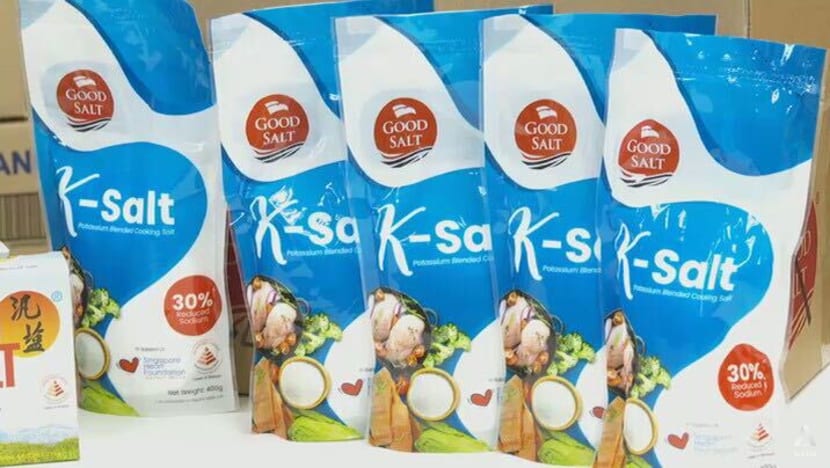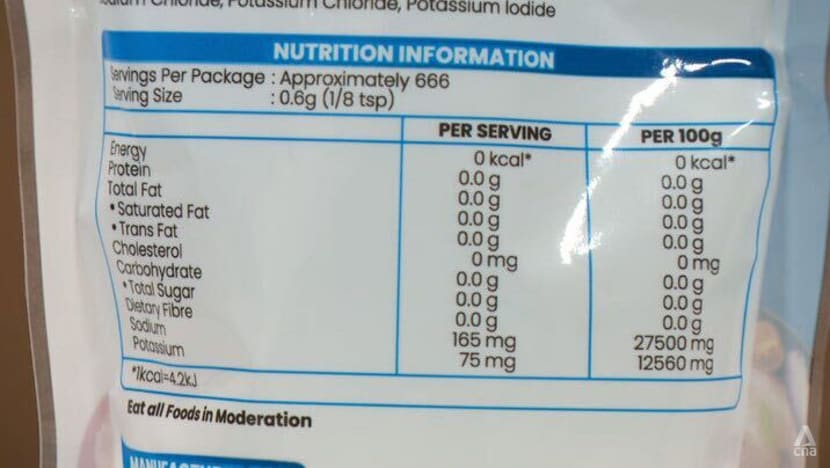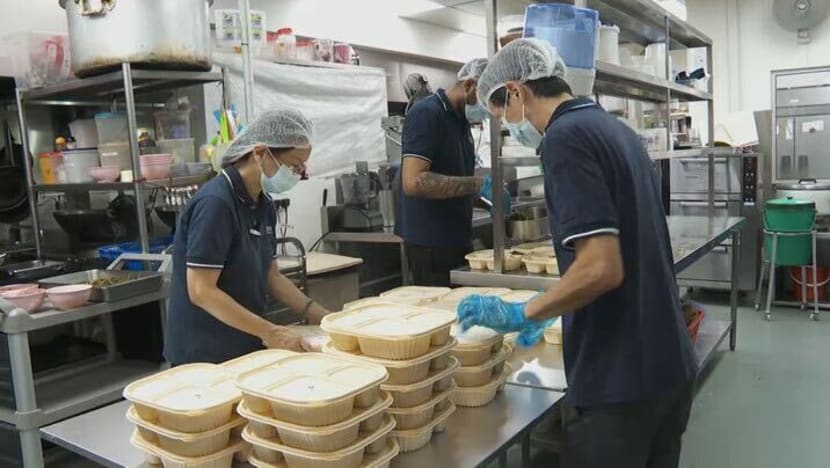Replace regular salt with alternatives, says HPB in push to reduce sodium intake in Singapore
Singapore residents consume an average of 3,600mg of sodium a day, or more than one-and-a-half teaspoons of salt, nearly double the recommended limit.
SINGAPORE: To reduce sodium intake in Singapore, the Health Promotion Board (HPB) is pushing people to switch from regular salt to lower-sodium alternatives.
More than one in three Singaporeans have hypertension, an increase from one in four in 2017, according to the National Population Health Survey in 2020.
This is a major factor for cardiovascular disease and strokes, and the upward trend applies to all subgroups of age, gender and ethnicity, said HPB in a media briefing on Monday (Sep 28).
Singapore residents consume an average of 3,600mg of sodium, or more than one-and-a-half teaspoons of salt, a day. This is almost double that of the World Health Organization’s recommended daily limit of less than 2,000mg of sodium.
And sodium intake is growing as people in Singapore eat out more often, said HPB.
About 75 per cent of Singapore residents’ sodium intake comes from added salt, which refers to salt, sauces or seasoning added to meals. The remaining 25 per cent is “hidden” sodium in processed food. This sets Singapore apart from Western countries where the main contributor of sodium in diets is processed food.
HPB aims to reduce Singapore’s sodium intake by about 15 per cent over the next five years, shaving off a quarter teaspoon of salt per person per day.
The Ministry of Health announced earlier this year at the Committee of Supply debate in March that it would introduce measures to curb sodium consumption.
It said at the time that HPB would work with salt suppliers and the food service sector to encourage the substitution of regular salt used in cooking with lower-sodium alternatives.
HPB has also ramped up efforts under the Healthier Ingredient Development Scheme to spur industry reformulation of lower-sodium salt, sauces and seasonings to further increase the range and variety of healthier choices.
WHAT ARE LOWER-SODIUM SALT ALTERNATIVES?
Regular salt is made up of 100 per cent sodium chloride, and typically contains 2,000mg of sodium per teaspoon.
Other popular salts like Himalayan pink salt, sea salt or kosher salt are also mostly sodium chloride, with a small concentration of other minerals that may be marketed as good for health. These also contain about 1,900 to 2,000mg of sodium per teaspoon.
In many lower-sodium salts, the sodium is partially substituted with potassium. These contain about 1,500mg of sodium per teaspoon or less, about 30 per cent less sodium than regular salt.
Another common salt Singapore residents may be familiar with is MSG, or monosodium glutamate, which is often used as a flavour additive. MSG contains 12 per cent sodium, which is less than regular salt.
The public perceives MSG to be unhealthy, but nutritionally it is the same as other naturally occurring sources of flavour enhancers, HPB said.
MSG can be found in foods like tomatoes, cheese or kombu, which is a type of Japanese kelp used for soups.
What are sodium and potassium and why do we need them?
Sodium is essential in maintaining a healthy blood pressure, but excessive sodium intake promotes water retention, increasing blood volume and blood pressure, said HPB.
This could cause artery walls to thicken to cope with the strain, narrowing them, which in turn causes blood pressure to increase further.
This cycle can cause blood vessels to rupture or blood clots to form, leading to heart attacks and strokes.
Potassium is an essential mineral in our diets, and is found naturally in spinach, broccoli or bananas.
It works in the opposite way from sodium, helping to ease tension in blood vessels, which helps to lower blood pressure.
Responding to a question about whether Singapore would consider implementing a sodium tax on processed foods that are high in salt, HPB said other countries have done so.
The authorities will monitor the issue over time and assess the situation, said HPB.
Even if it considers a sodium tax, HPB said it will look at such a move "holistically" and whether it can adapt this to the local market.
Currently, lower-sodium salt alternatives have about 2 per cent of the market share, and HPB hopes that with its efforts, this will increase to 50 per cent.
About 25 per cent of the sauces and seasonings available in Singapore are lower-sodium options and have the Healthier Choice symbol.
In early October, a new lower-sodium salt named K-salt will hit supermarkets here - K being the chemical symbol for potassium. HPB is also working with major retailers to introduce house brand lower-sodium salt by next year, it said.
Manufactured by IMI Lifestyle Products, K-salt will retail at S$2.50 for a 400g pack. The company’s managing director Goh Chiew Seng said this will typically last a family about three months.
“It is not expensive actually,” he added.
“We are hoping that there’ll be higher demand, but … we are fighting the habit too. We are all creatures of habit, so hopefully we can change that habit in a significant way, because national health is involved and the implication of a high sodium intake for any country is not very good.”
The average Singaporean consumes 2,500mg of potassium per day, below the recommended 3,500mg to 4,700mg, said the health authorities.
Substituting regular salt with a lower-sodium salt alternative that contains potassium could boost daily intake, reducing blood pressure and the risk of cardiovascular disease, said HPB.
For example, each teaspoon of K-salt provides an average of 700mg of potassium, based on the 30 per cent potassium replacement in the salt.
IMI, which has been around for more than 20 years, is already bringing in a lower-sodium salt under the GoodSalt brand. Available in supermarkets, GoodSalt is a mineral salt with half the sodium content and added magnesium and potassium.
However, most alternatives like GoodSalt currently cost about 10 times more than regular salt.
IMI developed K-salt with HPB’s support under the Healthier Ingredient Development Scheme. This is why K-salt is expected to be priced at just three to four times more than regular salt, similar to the prices of “natural” salts like sea salt or kosher salt.
About 10 salt, sauces and seasoning suppliers have tapped on the Healthier Ingredient Development Scheme, and HPB expects two to three more salt suppliers to join the scheme next year.
“Of course, added ingredients mean increased production costs. The ingredients themselves are also slightly more expensive. But really the bottom line is volume. Where there’s enough volume, the price should be affordable to almost every family anywhere in the world,” said Mr Goh.


HOW DOES IT TASTE?
But how does lower-sodium salt taste compared with regular salt? According to HPB, switching to these alternatives will not compromise the taste of your food.
Close to 150 caterers have switched to these lower-sodium salts, sauces and seasonings as a default, and HPB is hoping to partner major food chain operators like Foodfare and Kopitiam to do the same.
LPH Catering has made the switch to K-salt permanently. The food caterer's general manager Shoan Lee said his chefs tested the K-salt in dishes and found the transition “smooth”.
“We tried and we realised that it’s easy to tweak the taste of the dishes,” Mr Lee said, adding that most recipes did not have to be tweaked at all.
“It doesn’t really affect the dishes’ taste, and it’s also healthier, so we were very convinced to change (the salt we use).”


In testing whether a switch to lower-sodium salts would be feasible for the food service industry, HPB worked with two caterers, Sodexo and NTWU Canteen, in a four-week trial last year.
The trial found that the amount of sodium used in each meal was significantly lower, at about 450mg a meal. This also included results from switching out sauces and seasonings to lower-sodium alternatives.
Chefs also found it convenient to use lower-sodium salt and did not have to change their recipes, said HPB. The cost increase was less than 0.1 cent a meal.
More than 80 per cent of the employees who ate at the canteens also said the food tasted the same.
Salt is needed for marinating food and seasoning, and it is sometimes not feasible to reduce the amount used, LPH Catering's Mr Lee said.
While it took “a little bit of effort” to convince his “very traditional” chefs, Mr Lee said they came around after he cooked the food himself with K-salt and asked them to taste the food.
After switching to the new K-salt, LPH Catering told its customers about the change and that they could opt for a healthier menu.
“There’s really no feedback on what they think. So I would think that no feedback is good feedback,” said Mr Lee. “It didn’t change the taste of the dishes, so it wasn’t like (if) you choose the healthier choice, you’re eating very bland food.”
















